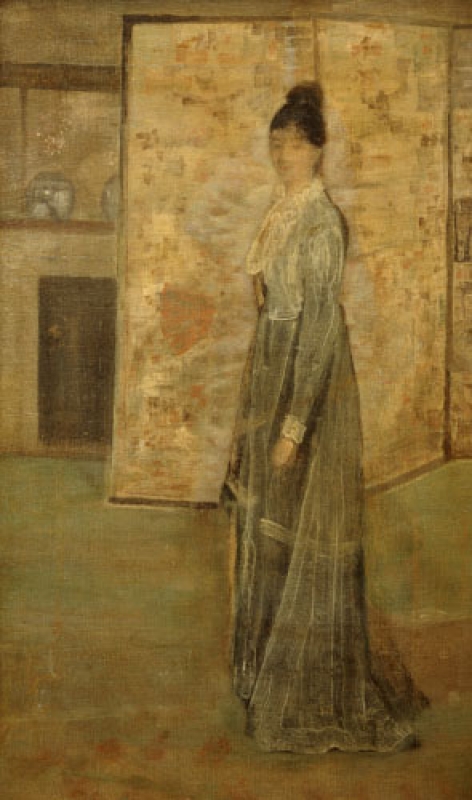Provenance
- In or before 1910: Walter Thomas Spencer (1864-1936) , a second-hand bookseller at 27 New Oxford Street, sold 'rolls of canvases' to Frida Uhl Strindberg (1872-1943) ;
- 1910, September: Mme Strindberg sold about fifty canvases to Messrs Dowdeswell;
- 1910: on 15 September Dowdeswell showed Elizabeth Robins Pennell (1855-1936) an unsigned painting, which matches the description of Arrangement in Flesh Colour and Grey: The Chinese Screen;
- 1917: sold by Messrs Dowdeswell at auction, Christie's, London, 9 February 1917 (lot 309) as 'The Chinese Screen; an arrangement in Flesh-colour and grey' by Walter Greaves (1846-1930), and bought by 'Martin' for 25 guineas.
- 1924: sold by a private collector through the Leicester Galleries to Maud Field (Mrs H. G. Clegg) (1872-1933) ;
- 1933: on her death, passed to her daughter, Laura Kathleen Clegg, Lady Ismay (1897-1978) ;
- 1965: given to her daughter, Sarah Field Ismay (Viscountess Allendale) (b. 1928) , Stocksfield-on-Tyne, Northumberland.
- After 1980: acquired for a private collection.
The early provenance of this painting is unknown.
It has been suggested that the history of Arrangement in Flesh Colour and Grey: The Chinese Screen goes back to Whistler's bankruptcy in 1879, when the Receiver, James Waddell (b. 1838), gave Whistler permission to destroy unfinished work. There is, however, no proof that this painting was among the destroyed works.
Arrangement in Flesh Colour and Grey: The Chinese Screen is associated with a group of paintings that may or may not have been originally painted by Whistler. The recorded history of this group starts in 1910.
In 1910 Elizabeth Robins Pennell (1855-1936) and Joseph Pennell (1860-1926) were shown a very large group of paintings by the London art dealers Messrs Dowdeswell and Dowdeswell. 1 Joseph Pennell speculated that these rolls of canvases might have come from Walter Greaves (1846-1930), or 'directly or indirectly', from Charles Augustus Howell (1840?-1890) or his heirs. 2
Walter Dowdeswell (1858-1929) described the history of these canvasses as he understood it. Walter T. Spencer, a second-hand bookseller at 27 New Oxford Street, sold 'rolls of canvases' to Frida Strindberg 'for nothing'; and in September 1910 Mme Strindberg sold 'about fifty' to Messrs Dowdeswell, who described the paintings as 'shockingly dirty but they saw passages that were unmistakably Whistler'. 3 On 15 September Dowdeswell showed Elizabeth Robins Pennell (1855-1936) an unsigned painting of an interior,
‘a woman, with black hair done up high on her head, wearing a grey dress, standing in front of a Japanese screen, a mantelpiece not unlike the mantelpiece in "The Little White Girl" behind it, not particularly good but the skirt was absolutely the Whistler of "The Six Projects": evidently a study of Miss Spartali for "La Princess du Pays de la Porcelaine".' 4
This description fits Arrangement in Flesh Colour and Grey: The Chinese Screen but the Pennells were wrong in suggesting that it was a study of Marie Spartali (Mrs W. J. Stillman) (1844-1927) for La Princesse du pays de la porcelaine [YMSM 050].
Furthermore, it would appear that doubts grew as to the authorship of Arrangement in Flesh Colour and Grey: The Chinese Screen, which was sold as by Walter Greaves (1846-1930) by Messrs Dowdeswell in 1917. 5
Exhibitions
It was not exhibited in Whistler's lifetime.
Last updated: 4th June 2020 by Margaret






